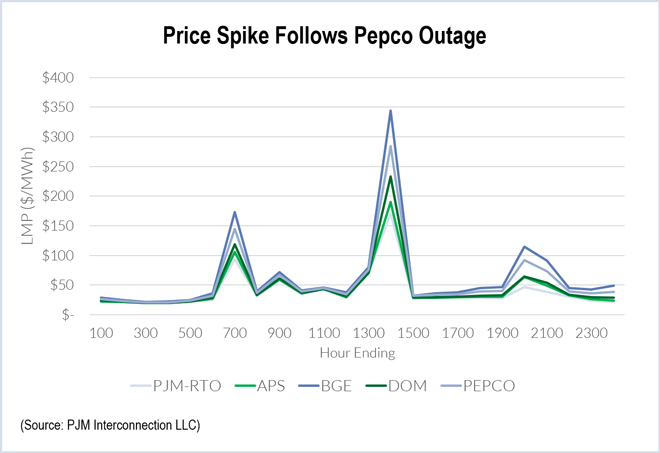By Suzanne Herel
PJM and utility officials said yesterday they are still investigating what caused the failure of a 230-kV transmission line that briefly cut power to the White House and much of the D.C. area Tuesday afternoon.
The incident caused a drop in voltage that led the Calvert Cliffs nuclear units to trip offline and federal agencies and other customers to transfer to their backup systems.

The Southern Maryland Electric Cooperative (SMECO) said the incident occurred at the Ryceville substation in Charles County when a PEPCO conductor “broke free from its support structure and fell to the ground.” CNN reported that local firefighters extinguished a small fire at the substation, which is jointly owned by PEPCO and SMECO.
“No other outside influences are expected,” Pilong said. “It was just a fault, a failed insulator.”
Maintenance Outage
Pilong said the incident occurred while several 230-kV lines in the area were out of service for planned maintenance and that the problem was exacerbated by a stuck breaker. Three remaining 230-kV lines and a 500-kV bus were lost, and the fault and voltage drop “rippled” to surrounding substations, he said.
SMECO said the failure cut power to its Ryceville and Hewitt Road stations as well as PEPCO’s supply to the Morgantown and Chalk Point interconnections. “No SMECO equipment was damaged and all protective devices operated correctly to isolate SMECO equipment from the PEPCO fault,” it said.
The grid recovered — returning its area control error to normal bounds — in about seven minutes, Pilong said.
The outage trapped people in elevators, darkened D.C.’s subway stations and caused some institutions — including a Department of Energy building, the main campus of the University of Maryland and some Smithsonian museums — to shut down for hours, The Washington Post reported.
Wholesale Prices Spike
In addition to causing disruptions to consumers and businesses, the incident resulted in a spike in wholesale prices, with real-time LMPs in the BGE zone rising from less than $38 at noon to more than $344 for the 1-2 p.m. hour. The other zones most affected were DOM, PEPCO and APS (see chart).
Initially, it was thought that up to 500 MW might have been lost, but later it was determined that customers had switched to off-grid power. About 300 MW returned to the grid within 40 minutes, PIlong said. By late afternoon, only the line that was the source of the fault was out of service.
“There was never a loss of permanent supply of electricity to customers,” PEPCO said.
Calvert Cliffs
Exelon, which operates the Calvert Cliffs units, said the plant shut down automatically as designed during significant electrical disturbances. However, Exelon told the Nuclear Regulatory Commission it is investigating why an emergency diesel generator serving Unit 2 did not start.
“Both reactors will remain in ‘hot shut-down,’ which means the reactor remains ready to resume power production, until the offsite grid disturbance can be addressed,” Exelon said.
As of Wednesday evening, the NRC still listed output at Units 1 and 2, which have a combined capacity of 5,474 MW, as zero.


